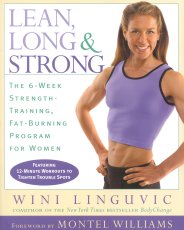 Excerpt
from Lean, Long & Strong: The 6-Week Strength-Training, Fat-Burning Program for Women
Excerpt
from Lean, Long & Strong: The 6-Week Strength-Training, Fat-Burning Program for Women
by Wini Linguvic
Using a Heart Rate Monitor
If you want to get more exact with your precision cardio, you can use a heart rate monitor in addition to evaluating your rate of perceived exertion. The heart rate monitor will tell you exactly what your heart rate is as you're exercising, which means you can then increase or decrease your intensity to get a precise workout. Monitors are available at sporting goods stores and some department stores.
First, you'll need to figure out the heart rate range that you should be working at. The best way to do this is to get tested by an exercise physiologist. If you don't want to do that, you can get a pretty good estimate by calculating your maximum heart rate and then calculating certain percentages of this rate to work at for your warm up and cool down, your moderate pace, and your interval pace. This will be a good starting point, though keep in mind that this calculation is based on the "average" person -- something that none of us is!
To estimate your maximum heart rate, subtract your age from 226. (Men would subtract their age from 220.)
226 - your age = age-adjusted maximum heart rate
Now, take your age-adjusted maximum heart rate and calculate the following percentages for the various parts of your workout.
-
60 percent for your warmup and cooldown
-
65 to 75 percent for your moderate pace
-
75 to 85 percent for your vigorous or interval pace
For instance, a 40-year-old woman's estimated maximum heart rate is 186 (226 - 40 = 186).
-
60 percent of her max = 112
-
65 percent of her max = 121
-
75 percent of her max = 140
-
85 percent of her max = 158
Reprinted from: Lean, Long & Strong: The 6-Week Strength-Training, Fat-Burning Program for Women By Wini Linguvic © 2005 Wini Linguvic. Permission granted by Rodale, Inc., Emmaus, PA 18098.
